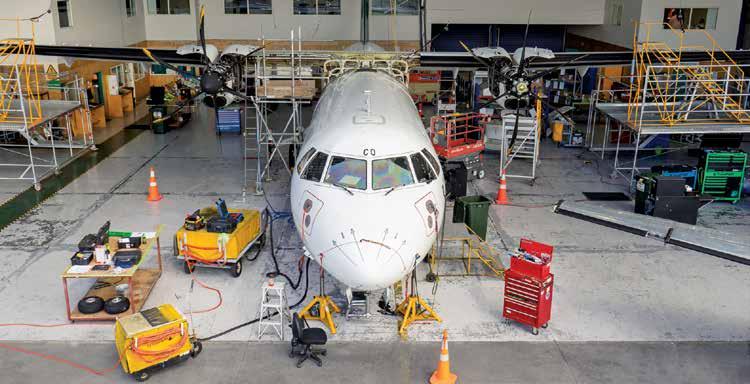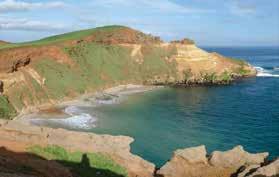
5 minute read
SAFETY FIRST It’s safety first as we bring our
Looking after the things we love
Engineers Harry Makahununiu and Andre Jaworski at work on the Air Chathams ATR
Advertisement
Safety First
AS A FAMILY OWNED AIRLINE Air Chathams understands the importance of looking after the things we love - you, our customers, our family of staff, our community and our fleet - and in the next few issues of Air Chats we’ll be taking a look at how we put this into action. And because it’s always been safety first for us, first up in the series we’re looking at taking care of the aircraft that we use on a daily basis to connect Kiwis all around Aotearoa New Zealand.
Air Chathams has grown exponentially in the last ten years. We now fly into more locations and carry more Kiwis around the country than ever before, and our team has grown in parallel to that so that we can continue to deliver the same service our passengers have come to expect. But there is a lot more to that than making sure check-in is smooth and the beloved Timtams are onboard. With a large and growing fleet of aircraft, we have also made sure that our maintenance team has grown with us, ensuring that we can also continue to keep working on all of our own aircraft - they’re part of the family, and we like to know they’re in great hands.
As part of this process Air Chathams is now certified by the Civil Aviation Authority (CAA) to carry out the most comprehensive and important safety check procedures in the industry. Known as a Heavy Maintenance Visit (HMV), this is a detailed, state of the art look at the state of health of our aircraft, and we think there is no one better to do this than our team who work with and on our aircraft each and every day; they know them like their own, and take real pride in keeping them in tip top condition.

“A Heavy Maintenance Visit is carried out according to the age and utilisation of the aircraft,” says Brian Porter, Head of Maintenance at Air Chathams and someone with 45 years of experience in maintaining aircraft. “So essentially that means the number of hours and cycles it has been in use, though the different aircraft in our fleet have different levels of technology on board and so have different maintenance schedules. In the case of our ATR, the HMV was carried out at the 4,000 hour, two year mark and meant close inspection of the flight deck, nose section fuselage, internal midsection, and outboard wing sections, and covering avionics, wiring, hydraulics, everything.”
And when Brian says close inspection, he means a very close inspection. “Basically we take the aircraft apart and put it back together,” he says. “In New Zealand we have one of the harshest environments on earth for aircraft, because nearly all our airports are located near the ocean and salt is the enemy of an aircraft as it causes corrosion. But because of that, in New Zealand we are also the best in the world at dealing with this issue. Kiwis are pretty can-do, and at Air Chathams we can remanufacture if necessary, because we’re true aircraft engineers as opposed to parts replacement people. It’s what the old guard like me were trained to do - and it’s great that at Air Chathams we are hiring new trade trainees and passing on those skills.” In addition to the high-level skill set needed for this work, there is also a great deal of specialised tooling required - and because the Air Chathams fleet has five different aircraft types on the roster that’s quite a few tools. Each of the three Saab 340s (affectionately known as the ‘Swedish Princesses’), the ATR 72-500, our three trusty Metroliners, the ever-popular DC3, and our Cessna 206 all have different avionic systems and engine types, so while this may not be rocket science, it’s probably as close as it gets outside of the space programme.



Let’s put it this way. The HMV check on the ATR took 1883 man hours and over a quarter million dollars of materials to complete. “That was 12 guys working ten-hour days, six days a week, for four weeks,” says Brian, “and before we brought the aircraft in we spent eight weeks planning the job, because ‘prior planning prevents poor performance’! We need to know exactly what we are doing and what we are going to need - it’s not like we can pop in to Mitre 10 if we need something!”
These types of checks were previously carried out for Air Chathams aircraft by Air New Zealand maintenance crews, but as Adrian Ali, Air Chathams’ Commercial Manager says, the airline was keen to see this become an in-house process. “Becoming certified by the CAA was quite a stringent process,” Adrian says, “but we think it was well worth the effort. For a start it meant that we no longer have to position our aircraft to approved maintenance locations within New Zealand, and that meant cost savings, but most of all we wanted out Air Chathams team to have the opportunity to up-skill and gain the extensive experience required to carry out this work. They have a real sense of pride in making sure our aircraft are always ready to carry our passengers and crew safely around the country - and we think that sense of ownership is priceless.”
= = = = = = = = = Let’s unlock = = = = = = = = = = = = = = = = = = = = = = the potential = = = = = = = = = = = = = = = = = = = = = = = = = = = = = = = = = = = = = = = = = = = =in your property = = = = = = = = = = = = = = = = = =
Subdivisions
Planning and Engineering Wastewater Consents
Aerial Photography and Mapping Farm Mapping
We are land development consultants specialising in planning, surveying and engineering design. We’re regularly making trips to the Chathams and we put the effort in up front to make sure you get the most from your land.
Consult our experts to ensure your project gets off on the right foot.
Contact Andrew Ledingham Call 03 339 0401 Email andrew.l@blg.nz
Canterbury 0800 BLG 123 Marlborough 0800 BLG 123 Visit blg.co.nz

